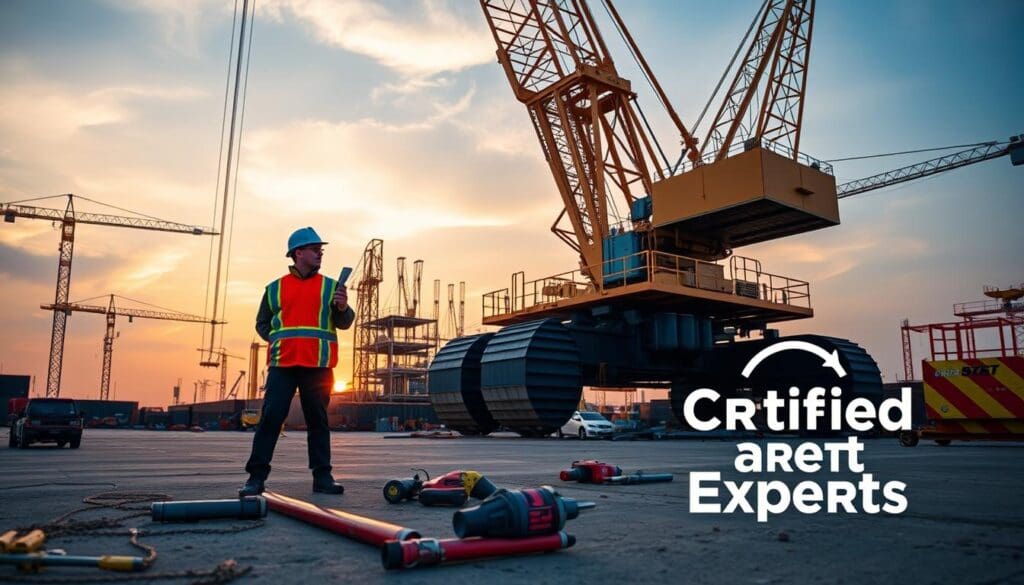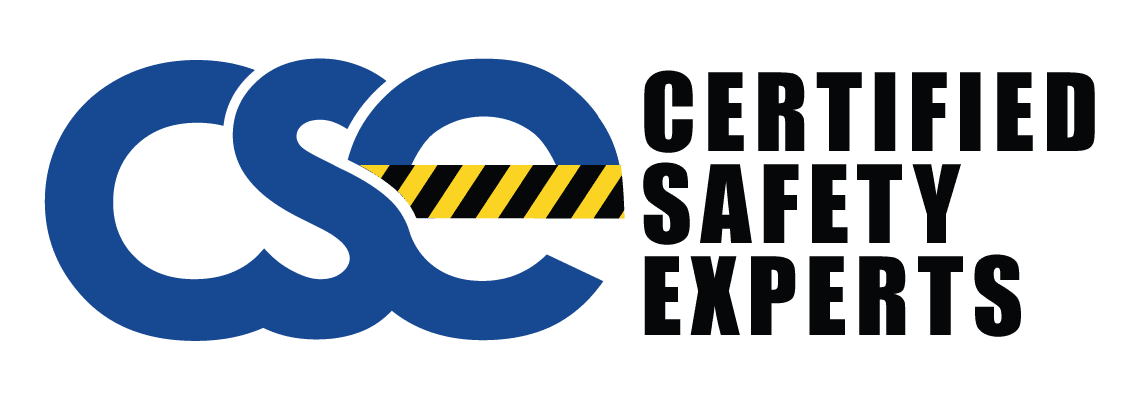How often should cranes be checked to keep them safe and working right? This question is key to making sure cranes are safe in the US. It’s vital to know why regular checks are important. They help cut down on accidents, make equipment last longer, and follow the law.
With facts from the Occupational Safety and Health Administration (OSHA) and real-world examples, we see how often these checks matter. The frequency of inspections affects safety and how much things cost.
Key Takeaways
- Regular inspections are crucial for crane safety and preventing accidents.
- Following OSHA rules lowers legal risks.
- Regular checks help crane equipment last longer.
- Good inspection schedules can cut down on maintenance costs over time.
- Experts stress the need for consistent checks.
Understanding Crane Inspection Frequency
Crane inspection frequency is key to keeping cranes safe and efficient. Laws require regular checks to make sure cranes don’t risk operators or the area around them. It’s important to know the different kinds of crane inspections to follow these rules.
Definition and Importance
The term crane inspection frequency means how often cranes get checked. This depends on how much they’re used, the environment they’re in, and what laws say. These checks are vital because they spot problems early, keeping the equipment safe and working well for a long time.
Types of Inspections
Cranes go through different kinds of inspections, each with its own purpose:
- Initial Inspections: These happen when a crane is first put into use or after big changes. They make sure the crane is safe and works right.
- Frequent Inspections: Done often, like every day or week, these check if the crane is ready to work and safe to use. They look at both how it looks and how it works.
- Periodic Inspections: These are more detailed, happening every month or year. They check all parts of the crane thoroughly. These are key for keeping the crane in good shape over time.
Checks for operational readiness and mandatory compliance are big parts of frequent inspections. Mandatory checks make sure cranes follow OSHA rules. Operational checks look at how cranes work every day.
The American National Standards Institute (ANSI) has clear guidelines for crane inspections. It shows how important it is to follow crane maintenance schedules for each inspection type. Experts pick the right inspections based on how the crane is used and its surroundings. This helps keep cranes running safely and well.
Regulatory Requirements for Crane Inspections
Following the rules for crane inspections is key to keeping workplaces safe and avoiding legal trouble. Two main sets of rules guide how to inspect cranes: OSHA guidelines and ANSI standards. These rules tell us what steps to take and what documents to keep to stay legal and keep our licenses.

OSHA Guidelines
The Occupational Safety and Health Administration (OSHA) has clear rules for checking cranes under OSHA 1910.179. These rules say how often and what kind of inspections are needed, like daily, monthly, and yearly checks. They focus on checking mechanical parts, the structure, and control systems to make sure they’re safe. Not following these rules can lead to big fines and legal trouble.
ANSI Standards
The American National Standards Institute (ANSI) adds to OSHA’s rules with its own standards in ANSI B30. These standards cover different types of cranes and lifting gear, with details on technical specs and safety rules. ANSI says we must keep detailed records of inspections and fix any problems quickly. Following these standards makes sure we’re safe, efficient, and reliable.
Best Practices for Crane Inspections
Following the best practices for crane inspections is key to a safe work area and crane efficiency. These methods help meet regulatory needs and encourage early maintenance.
Keeping detailed records is vital. It tracks the crane’s state and spots trends that might show future problems. It’s wise to have logs with the date, time, and results of each check.
Choosing skilled people for inspections is crucial. Inspections should be done by those who are well-trained and certified. This way, any issues are caught early, preventing accidents or equipment failure.
Using technology helps improve inspection methods. Tools like drones, 3D imaging, and sensors offer detailed analysis and real-time data. This makes inspections quicker and more precise.
Important crane inspection practices include:
- Keeping a detailed and current inspection log
- Having all inspections done by certified experts
- Using tech tools like drones and sensors for accurate checks
- Following OSHA’s best practice advice
- Regularly checking and updating inspection methods based on new safety rules and tech advances
By following these *crane safety guidelines* and best practices, companies can lower risks. They can also make sure their crane equipment lasts longer and works well.
Inspection Intervals for Cranes
Crane safety and efficiency rely on following strict inspection schedules. This part explains the key inspection times for cranes. It shows why regular checks are crucial for keeping cranes in top shape and meeting safety rules.
Daily and Pre-Shift Inspections
Crane operators must do daily and pre-shift inspections before starting work. These checks focus on important parts like:
- Brakes
- Hooks and load lines
- Hydraulic systems
- Control mechanisms
These quick but detailed checks are key to spotting issues that could be dangerous. Doing these checks every day helps stop accidents and breakdowns.

Monthly and Annual Inspections
After daily checks, more detailed reviews are needed. Monthly and annual inspections are vital for keeping cranes safe. They look at:
- Structural integrity
- Electrical components
- Wire rope condition
- Limit switches
- Functional tests
Monthly checks aim to catch wear and tear missed in daily checks. Annual checks, often required by OSHA and ANSI, make sure everything meets strict safety standards. They give a full check-up of the crane’s condition.
Following these inspection times for cranes, including monthly and annual inspections, is key. It ensures safe and efficient crane operation over the long term.
Cranes Maintenance Schedules
A well-structured maintenance schedule is key for cranes to work well and safely over time. Following a set crane maintenance schedule helps businesses avoid downtime and make their machines last longer.
Creating strong crane maintenance schedules means doing regular checks and taking preventive steps. It’s important to have daily checks before shifts and a full check every month. This way, any problems are caught early, lowering the chance of sudden breakdowns.
It’s also crucial to use what you learn from these checks to improve your maintenance plan. For instance, finding issues during inspections can help you fix them before they cause bigger problems. This makes your maintenance more effective.
Guidelines from top crane groups and industry leaders say a good maintenance plan includes:
- Daily visual checks for wear or damage.
- Weekly tests to make sure everything works and is safe.
- Monthly detailed inspections to note technical issues.
- Semi-annual maintenance for important parts like hydraulics and electricals.
- Annual checks for the whole crane’s structure and performance.
Keeping a crane well-maintained makes it safer and more productive. Studies show that following a maintenance schedule can cut costs and improve how well assets are used.
Using a strategic approach to crane maintenance, with regular checks and quick fixes, sets up a strong and efficient way of working.
Updating crane inspection schedules and using what you learn in a detailed maintenance plan helps protect your equipment. This ensures smooth operation.
For companies aiming for top crane operations, sticking to a well-thought-out maintenance schedule is a must.
Conclusion
Keeping cranes safe and reliable is key for any business in the U.S. It’s vital to know and follow crane safety rules. Regular checks are crucial for keeping things running smoothly and avoiding accidents. By following OSHA and ANSI rules, companies can make their workplaces safer and cut down on costly downtime.
This article showed how important it is to check cranes often. Daily and before starting work, plus monthly and yearly checks, help keep cranes safe and lasting longer. Also, having strict maintenance plans helps ensure cranes work well and perform better.
For those who care about crane safety and want top standards, working with experts in crane checks and upkeep is smart. These pros make sure all safety steps are taken, giving business owners peace of mind. To book a crane inspection and maintenance service, call (919) 326-3742. This is a big step towards keeping your operations safe.




